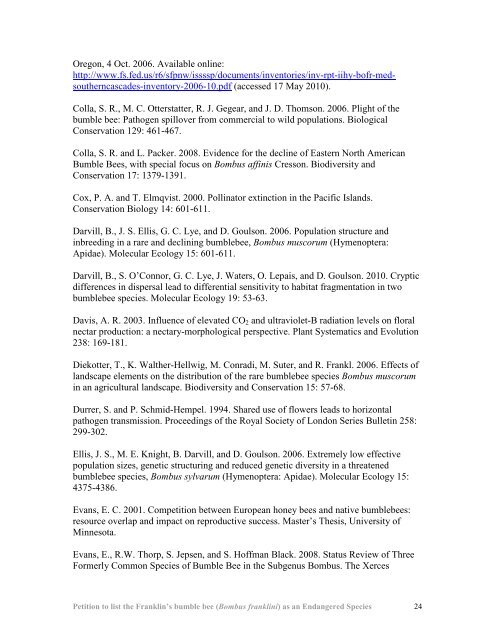Franklin's bumble bee - The Xerces Society
Franklin's bumble bee - The Xerces Society
Franklin's bumble bee - The Xerces Society
You also want an ePaper? Increase the reach of your titles
YUMPU automatically turns print PDFs into web optimized ePapers that Google loves.
Oregon, 4 Oct. 2006. Available online:<br />
http://www.fs.fed.us/r6/sfpnw/issssp/documents/inventories/inv-rpt-iihy-bofr-medsoutherncascades-inventory-2006-10.pdf<br />
(accessed 17 May 2010).<br />
Colla, S. R., M. C. Otterstatter, R. J. Gegear, and J. D. Thomson. 2006. Plight of the<br />
<strong>bumble</strong> <strong>bee</strong>: Pathogen spillover from commercial to wild populations. Biological<br />
Conservation 129: 461-467.<br />
Colla, S. R. and L. Packer. 2008. Evidence for the decline of Eastern North American<br />
Bumble Bees, with special focus on Bombus affinis Cresson. Biodiversity and<br />
Conservation 17: 1379-1391.<br />
Cox, P. A. and T. Elmqvist. 2000. Pollinator extinction in the Pacific Islands.<br />
Conservation Biology 14: 601-611.<br />
Darvill, B., J. S. Ellis, G. C. Lye, and D. Goulson. 2006. Population structure and<br />
inbreeding in a rare and declining <strong>bumble</strong><strong>bee</strong>, Bombus muscorum (Hymenoptera:<br />
Apidae). Molecular Ecology 15: 601-611.<br />
Darvill, B., S. O’Connor, G. C. Lye, J. Waters, O. Lepais, and D. Goulson. 2010. Cryptic<br />
differences in dispersal lead to differential sensitivity to habitat fragmentation in two<br />
<strong>bumble</strong><strong>bee</strong> species. Molecular Ecology 19: 53-63.<br />
Davis, A. R. 2003. Influence of elevated CO 2 and ultraviolet-B radiation levels on floral<br />
nectar production: a nectary-morphological perspective. Plant Systematics and Evolution<br />
238: 169-181.<br />
Diekotter, T., K. Walther-Hellwig, M. Conradi, M. Suter, and R. Frankl. 2006. Effects of<br />
landscape elements on the distribution of the rare <strong>bumble</strong><strong>bee</strong> species Bombus muscorum<br />
in an agricultural landscape. Biodiversity and Conservation 15: 57-68.<br />
Durrer, S. and P. Schmid-Hempel. 1994. Shared use of flowers leads to horizontal<br />
pathogen transmission. Proceedings of the Royal <strong>Society</strong> of London Series Bulletin 258:<br />
299-302.<br />
Ellis, J. S., M. E. Knight, B. Darvill, and D. Goulson. 2006. Extremely low effective<br />
population sizes, genetic structuring and reduced genetic diversity in a threatened<br />
<strong>bumble</strong><strong>bee</strong> species, Bombus sylvarum (Hymenoptera: Apidae). Molecular Ecology 15:<br />
4375-4386.<br />
Evans, E. C. 2001. Competition between European honey <strong>bee</strong>s and native <strong>bumble</strong><strong>bee</strong>s:<br />
resource overlap and impact on reproductive success. Master’s <strong>The</strong>sis, University of<br />
Minnesota.<br />
Evans, E., R.W. Thorp, S. Jepsen, and S. Hoffman Black. 2008. Status Review of Three<br />
Formerly Common Species of Bumble Bee in the Subgenus Bombus. <strong>The</strong> <strong>Xerces</strong><br />
Petition to list the Franklin’s <strong>bumble</strong> <strong>bee</strong> (Bombus franklini) as an Endangered Species 24
















